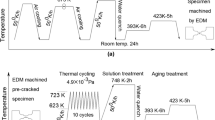Abstract
A volume element which is deformed becomes elongated and narrowed with increasing strain, for reasons of constant plastic volume; inclusion spacings experience the same changes. Equivalent plasticity expressions permit a description of this effect as a function of fracture strain. Such an effect must be taken into account in comparison of initial inclusion spacings with dimple sizes observed in tensile or toughness specimen fractures. It also plays a role in the assessment of dimple size changes in hydrogen-assisted ductile fracture. The most convenient way to display the effect in the hydrogen case is on a plot of ductility lossvs dimple size ratio. This comparison demonstrates that the geometrical effect generally should lead to large increases in size ratio as ductility decreases; thus the common observations of dimple sizereduction with hydrogen evidently represent large increases in dimple nucleation, while dimple sizeincreases may represent microvoid growth effects.
Similar content being viewed by others
References
H. C. Rogers:Ductility, pp. 31-61, ASM, Metals Park, Ohio, 1968.
A. R. Rosenfield:Met. Rev. (No. 121), 1968, vol. 13, pp. 29–40.
D. Broek:Int. Met. Rev. (sn. 185), 1974, vol. 19, pp. 135–82.
A. W. Thompson and P. F. Weihrauch:ScriptaMet., 1976, vol. 10, pp. 205–10.
J. M. Barsom and J. V. Pellegrino:Eng. Fract. Mech., 1973, vol. 5, pp. 209–21.
T. B. Cox and J. R. Low:Met. Tram., 1974, vol. 5, pp. 1457–70.
G. T. Hahn, C. R. Barnes, and A. R. Rosenfield:Influence of Microstructure and Second Phases on Fracture Toughness, Report ARL TR 75-0194, U.S. Air Force, Wright-Patterson AFB, Ohio, June 1975.
A. W. Thompson:Effect of Hydrogen on Behavior of Materials, pp. 467–77, TMS-AIME, New York, 1976.
I.M. Bernstein, R. Garber, and G. M. Pressouyre:Ibid., pp. 37–57.
A. W. Thompson and I. M. Bernstein:Fracture 0000, vol. 2, pp. 249–54, Univ. Waterloo Press, Waterloo, Ontario, 1977.
A. W. Thompson:Mater. Sci. Eng., 1974, vol. 14, pp. 253–64.
A. W. Thompson and J. A. Brooks:Met. Trans. A, 1975, vol. 6A, pp. 1431–42.
C. G. Rhodes and A. W. Thompson:Met. Trans. A, 1977, vol. 8A, pp. 949–54.
A. W. Thompson: Carnegie-Mellon University, Pittsburgh,PA, unpublished research, 1977.
R. Garber, 1. M. Bernstein, and A. W. Thompson:Scripta Met., 1976, vol. 10, pp. 341–45.
I. M. Bernstein and A. W. Thompson:Mechanisms of Environment Sensitive Cracking of Materials, pp. 412–24, The Metals Society, London, 1977.
J. E. Hilliard:Trans. TMS-AIME, 1962, vol. 224, pp. 1201–11.
J. Widgery and J.F. Knott:Metal Set, 1978,vol. 12, pp. 8–11.
G. Green and J. F. Knott:J. Eng. Mater. Tech. (Trans. ASME, SeriesH), 1976, vol. 98, pp. 37–46.
F. A. McClintock:J. Appl. Mech. (Trans. ASME, Series E), 1968, vol. 35, pp.363–71.
D. M. Tracey:Eng. Fracture Mech., 1971, vol. 3, pp. 301–15.
I. E. French and P. F. Weinrich:Met. Trans. A, 1976, vol. 7A, pp. 1841–45.
C. D. Beachem:J. Basic Eng. (Trans. ASME, Series D), 1965, vol. 87, pp. 299–306.
D. Broek:Eng. Fract. Mech., 1973, vol. 5, pp. 55–66.
R. H. Van Stone, R. H. Merchant, and J. R. Low:Fatigue and Fracture Toughness-Cryogenic Behavior (STP 556), pp. 93–124, A.S.T.M., Philadelphia, PA, 1974.
H. C. Burghard:Met. Trans., 1974, vol. 5, pp. 2083–94.
D. E. Passoja and D. C. Hill:Fractography-Microscopic Cracking Processes (STP 600), pp. 30–46, A.S.T.M., Philadelphia, PA, 1976.
G. Garrett and J. F. Knott:Met. Trans. A, 1978,vol. 9A,pp. 1187–1201.
D. P. Clausing:Int. J. Fract. Mech., 1970, vol. 6, pp. 71–85.
M. R. Louthan, G. R. Caskey, J. A. Donovan, and D. E. Rawl:Mater. Sci. Eng., 1972, vol. 10, pp. 357–68.
J. E. Hilliard:Metal Progress, 1964 (May), vol. 85, pp. 99–101.
A. W. Thompson:Metallography, 1972, vol. 5, pp. 366–69.
Garber, I. M. Bernstein, and A. W. Thompson: Carnegie-Mellon University, Pittsburgh, PA, unpublished research, 1976.
C. D. Beachem:Met. Trans., 1972, vol. 3, pp. 437–51.
H. Cialone and R. J. Asaro:Met. Trans. A, 1979, vol. 10A, pp. 367–75.
W. M. Robertson: Science Center, Rockwell International, Thousand Oaks, CA, unpublished research, 1976.
Author information
Authors and Affiliations
Rights and permissions
About this article
Cite this article
Thompson, A.W. Ductile fracture topography: Geometrical contributions and effects of hydrogen. Metall Trans A 10, 727–731 (1979). https://doi.org/10.1007/BF02658394
Received:
Issue Date:
DOI: https://doi.org/10.1007/BF02658394




